Existence and Asymptotic Behavior of Traveling Wave Fronts for a Time-Delayed Degenerate Diffusion Equation
Abstract
This paper is concerned with traveling wave fronts for a degenerate diffusion equation with time delay. We first establish the necessary and sufficient conditions to the existence of monotone increasing and decreasing traveling wave fronts, respectively. Moreover, special attention is paid to the asymptotic behavior of traveling wave fronts connecting two uniform steady states. Some previous results are extended.
1. Introduction
For other papers concerning the traveling wave solutions for degenerate diffusion equations without time delay, see [14–22]. From these results, we see that an obvious difference between the linear diffusion equations and the degenerate diffusion equations is that, in the degenerate diffusion case, there may exist traveling wave fronts of sharp type; that is, the support of the solution is bounded above or below, and at the boundary of the support, the derivative of the traveling wave solution is discontinuous. However, in the linear diffusion case, all traveling wave fronts are of smooth type; that is, the solutions are classical solutions, which approach the steady states at infinity.
Before going further, we first give the definition of sharp- and smooth-type traveling wave fronts.
Definition 1. A function φ(ξ) is called a traveling wave front with wave speed c > 0 if there exist ξa, ξb with −∞ ≤ ξa < ξb ≤ +∞ such that φ ∈ C2(ξa, ξb) is monotonic increasing and
- (i)
If ξa > −∞ and , then φ(ξ) is called an increasing sharp-type traveling wave front (see Figure 1(a)).
- (ii)
If ξa = −∞ or , then φ(ξ) is called an increasing smooth-type traveling wave front (see Figure 2(a)).
-
Similarly, we have the following.
- (iii)
If and , then φ(ξ) is called a decreasing sharp-type traveling wave front (see Figure 1(b)).
- (iv)
If or , then φ(ξ) is called a decreasing smooth-type traveling wave front (see Figure 2(b)).
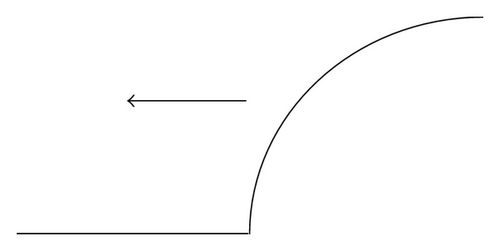
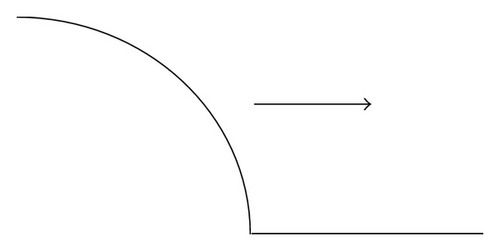
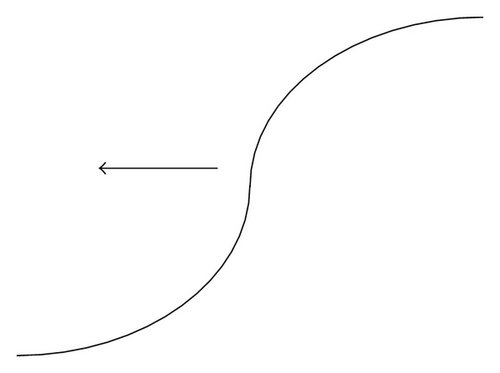
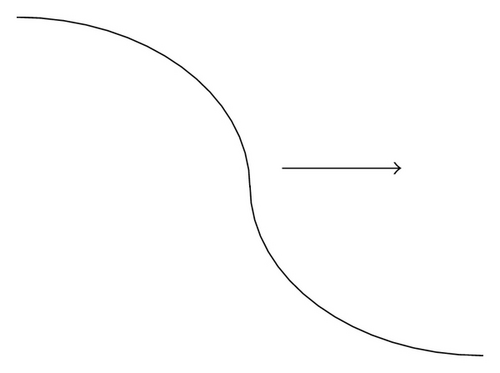
2. Existence of Increasing Traveling Waves
In this section, we aim to find a solution ψ(φ) of the problem (23) with ψ(φ) > 0 for φ ∈ (0,1).
Lemma 2. Assume that 0 < φ0 < 1 and ψ1(φ), ψ2(φ) are solutions of (24) corresponding to different wave speeds c1, c2, respectively, where ψ1(φ0) ≥ ψ2(φ0) > 0, ψ1(φ) > ψ2(φ) > 0 for 0 < φ < φ0, and φ1(ξ1) = φ2(ξ2) = φ0. Then, φ1(ξ1 − s) < φ2(ξ2 − s) if and φ1(ξ1 − s) = φ2(ξ2 − s) = 0 if .
Proof. Recalling (19), we see that
Lemma 3. For any given τ > 0, and c1 > c2 ≥ 0, let ψ1(φ), ψ2(φ) be solutions of (24) corresponding to c1, c2, respectively. Then, ψ1(φ) > ψ2(φ) for any φ ∈ (0, β2), where (0, β2) is the maximal existence interval of the solution ψ2(φ) > 0. In addition, ψ1(β2) > 0. (See Figure 3(a).)
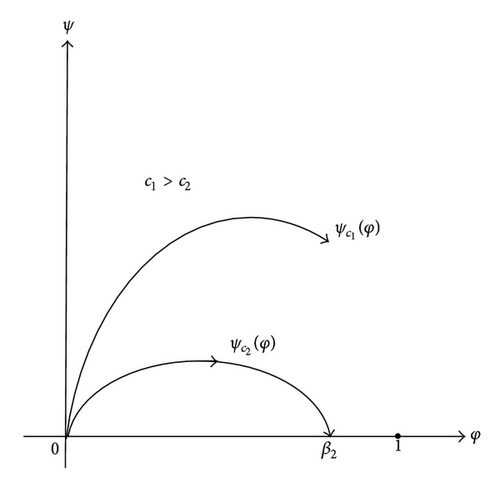
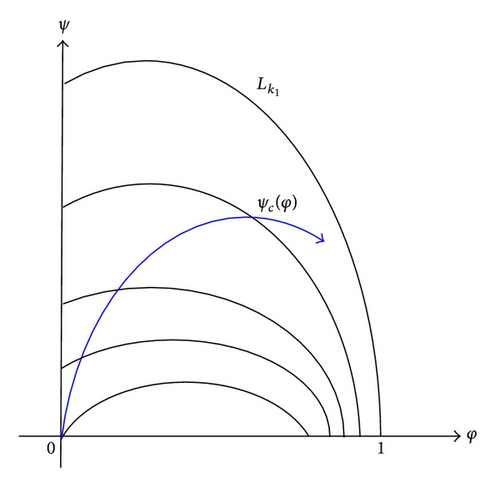
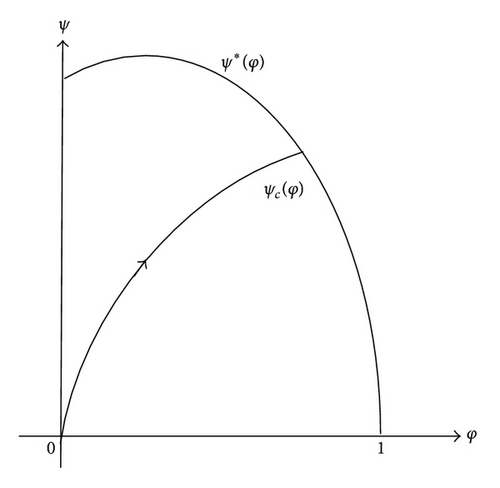
Proof. We first show that ψ1(φ) > ψ2(φ) for sufficiently small φ > 0. The argument consists of three cases, m + p > 2, m + p = 2, and 1 < m + p < 2.
(i) Consider the case m + p > 2. According to (24), we have
(ii) Consider the case m + p = 2. Similar to (i), we have
(iii) Consider the case 1 < m + p < 2. Notice that
We claim that ψ1(φ) > ψ2(φ) for any φ ∈ (0, β2). Suppose for contradiction that there exists φ0 ∈ (0, β2) such that ψ1(φ0) = ψ2(φ0) = ψ0 and ψ1(φ) > ψ2(φ) for φ ∈ (0, φ0). Then,
In what follows, we will show that ψ1(β2) > 0. Recalling the first equation of (24), we infer that
Lemma 4. The trajectory ψc(φ) of the problem (24) must intersect with ψ*(φ) for sufficiently large c > 0. (See Figure 3(c).)
Proof. For any φ ∈ (0, a], we have φcτ ∈ (0, a], and
Theorem 5. (i) If , then there is no nontrivial nonnegative solution for problem (23).
(ii) If , then there exists a unique , such that the problem (23) admits a nonnegative solution ψ(φ), and ψ(φ) > 0 for any φ ∈ (0,1).
Proof. (i) The case has been discussed.
(ii) We know that for any fixed c > 0, (φ, ψc) wanders through increasing level sets {Lk} strictly. Thus, (φ, ψc) intersects with a level set Lk at most once. Let (σc, ϕc) be the intersection point of (φ, ψc) with . Then, if ϕc > 0, we have
We first have . Indeed, when c = 0, the first equation of (24) becomes
In addition, by Lemma 3, we know that σc is decreasing on c. Assume that
Moreover, by Lemma 3, for , we have ψc(1) > 0. However, if , there exists φc with a < φc < 1 such that ψc(φ) → 0 as φ↗φc. The proof is completed.
Proposition 6. φ(ξ) is a monotone increasing sharp- or smooth-type traveling wave front of the problem (8)-(9) for some fixed c > 0, if and only if ψ(φ) with ψ(φ) > 0 for any φ ∈ (0,1) is a solution of the problem (23).
Proof. The necessity is clear. Consider the sufficient one. Let ψ(φ) > 0 for any φ ∈ (0,1) be a solution of the problem (23), and φ(ξ) solves
Theorem 5 and Proposition 6 imply the following result.
Theorem 7. (i) If , then there is no increasing traveling wave front for the problem (8)-(9).
(ii) If , then there is a unique wave speed , such that the problem (8)-(9) admits an increasing traveling wave front.
Furthermore, we have the following results.
Theorem 8. Let φ(ξ) be the traveling wave front of the problem (8)-(9) corresponding to the wave speed .
- (i)
If m < 2, then φ(ξ) is a smooth-type traveling wave front.
- (ii)
If m = 2, then and φ(ξ) is a sharp-type traveling wave front.
- (iii)
If m > 2, then and φ(ξ) is a sharp-type traveling wave front.
Proof. (i) If 0 < m ≤ 1, it is easy to see that
(ii) If m = 2, we have
(iii) If m > 2, we have
Theorem 9. is nonincreasing in delay τ; namely, if τ1 > τ2, then .
Proof. Suppose for contradiction that there exist time delays τ1 and τ2, with τ1 > τ2 and . Denote that and for simplicity. Take c such that
Similar to the proof of Lemma 3, we know that when φ > 0 is sufficiently small, for m + p > 2,
3. Existence of Decreasing Traveling Waves
In this section, we aim to find a solution ψ(φ) of the problem (23) with ψ(φ) < 0 for φ ∈ (0,1). We first introduce a comparison lemma.
Lemma 10. Let u, v be the solutions of the following problems, respectively:
Proof. Notice that φcτ ≤ φ when ψ is positive, and thus
The proof for ψ, u, v < 0 is similar and omitted here.
Lemma 11. Assume that 0 < φ0 < 1 and ψ1(φ), ψ2(φ) are solutions of (106) corresponding to different wave speeds c1, c2, respectively, where ψ1(φ0) ≤ ψ2(φ0) < 0, ψ1(φ) < ψ2(φ) < 0 for φ0 < φ < 1, and φ1(ξ1) = φ2(ξ2) = φ0. Then, φ1(ξ1 − s) > φ2(ξ2 − s) if , and φ1(ξ1 − s) = φ2(ξ2 − s) = 1 if .
Proof. The proof is similar to that of Lemma 2.
Lemma 12. For any given τ > 0, and c1 > c2 ≥ 0, let ψ1(φ), ψ2(φ) be solutions of (106) corresponding to c1, c2, respectively. Then, ψ1(φ) < ψ2(φ) for any φ ∈ (α2, 1), where (α2, 1) is the maximal existence interval of the solution ψ2(φ) < 0. In addition, ψ1(α2) < 0. (See Figure 4(a).)
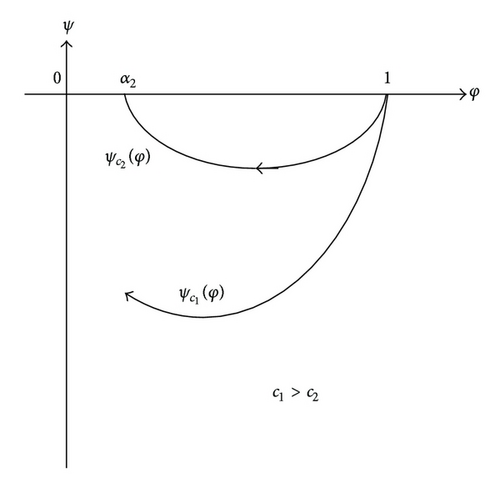
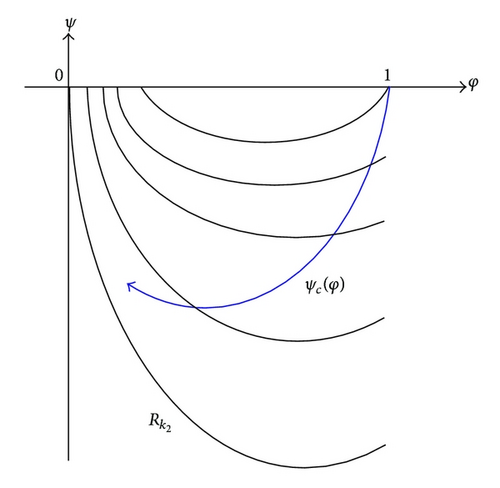
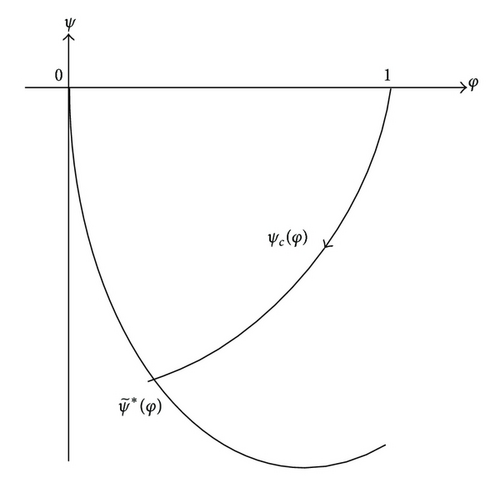
Proof. We first show that ψ1(φ) < ψ2(φ) if φ is in a sufficiently small left neighborhood of 1. The argument consists of three cases, q > 1, q = 1, and q < 1.
(i) Consider the case q > 1. According to (106), we have
(ii) When q = 1, consider the following two systems:
(iii) Consider the case 0 < q < 1. Notice that
The proof for the claims that ψ1(φ) < ψ2(φ) for any φ ∈ (α2, 1) and ψ1(α2) < 0 is similar to the proof of Lemma 3 and omitted here.
Lemma 13. The trajectory ψc(φ) of the problem (106) must intersect with for sufficiently large c > 0. (See Figure 4(c).)
Proof. For any φ ∈ [a, 1), we have φcτ ∈ [a, 1) and
Theorem 14. (i) If , then there is no nontrivial nonpositive solution for the problem (23).
(ii) If , then there exists a unique , such that the problem (23) admits a nonpositive solution ψ(φ), and ψ(φ) < 0 for any φ ∈ (0,1).
Proof. The proof is similar to that of Theorem 5, and
Proposition 15. φ(ξ) is a monotone decreasing sharp- or smooth-type traveling wave front of the problem (10)-(11) for some fixed c > 0, if and only if ψ(φ) with ψ(φ) < 0 for any φ ∈ (0,1) is a solution of the problem (23).
Proof. The proof is similar to that of Proposition 6.
Theorem 14 and Proposition 15 imply the following result.
Theorem 16. (i) If , then there is no decreasing traveling wave front for the problem (10)-(11).
(ii) If , then there is a unique wave speed , such that the problem (10)-(11) admits a decreasing traveling wave front.
Furthermore, we have the following results.
Theorem 17. The traveling wave front φ(ξ) of the problem (10)-(11) corresponding to the wave speed obtained earlier is of smooth type.
Proof. It is easy to see that
Theorem 18. is nonincreasing in delay τ; namely, if τ1 > τ2, then .
Proof. The proof is similar to that of Theorem 9.
4. Asymptotic Behavior of the Traveling Wave Solutions
In this section, we first pay our attention to the finiteness of . On the basis of this, the convergent rates of φ going to the steady states at far-field are discussed.
Theorem 19. Let φ(ξ) be the increasing traveling wave solution of the problem (8)-(9) corresponding to the unique wave speed .
- (i)
If 0 < q < 1, then ξb < +∞.
- (ii)
If q ≥ 1, then ξb = +∞. More precisely,
- (a)
when q > 1, one has
() - (b)
when q = 1, one has
()
- (a)
Proof. (i) For , we have , and
(ii) It is easy to see that
For any ε > 0, when φ approaches 1 enough, we have . Consider the following two problems:
On the other hand, let
Summing up, for any φ < 1 with , when q > 1,
Theorem 20. Let φ(ξ) be the increasing traveling wave solution of the problem (8)-(9) corresponding to the unique wave speed .
- (i)
If m > min {p, 1}, then ξa > −∞.
- (ii)
If m ≤ min {p, 1}, then ξa = −∞. More precisely,
- (a)
when m + p > 2, if m = 1, one has
() -
and if m < 1, one has
() - (b)
when m + p = 2, if m = 1, one has
() -
and if m < 1, one has
() - (c)
when 1 < m + p < 2, noticing that m ≤ min {p, 1}, then m ≤ p; if m = p, one has
() -
and if m < p, one has
()
- (a)
Proof. For any φ0 ∈ (0, a), we see that
Theorem 21. Let φ(ξ) be the decreasing traveling wave solution of the problem (10)-(11) corresponding to the unique wave speed .
- (i)
If 0 < q < 1, then .
- (ii)
If q ≥ 1, then . More precisely,
- (a)
when q > 1, one has
() - (b)
when q = 1, one has
()
- (a)
Proof. Let φ0 approach 1 enough. Then, we have
Theorem 22. Let φ(ξ) be the decreasing traveling wave solution of the problem (10)-(11) corresponding to the unique wave speed .
- (i)
If p < min {m, 1}, then .
- (ii)
If p ≥ min {m, 1}, then . More precisely,
- (a)
when m + p > 2, if p > 1, one has
() -
and if p = 1, one has
() - (b)
when m + p = 2, if p > 1, one has
() -
and if p = 1, one has
() - (c)
when 1 < m + p < 2, noticing that p ≥ min {m, 1}, then p ≥ m; if p > m, one has
() -
and if p = m, one has
()
- (a)
Proof. (i) For , we have , and
(ii) From the proof of Theorem 14, we know that
For any 0 < ε < a, when φ approaches 0 enough, we have . Consider the following problem:
When 1 < m + p < 2, take r = (m + p)/2. Then, (225) holds if
When m + p = 2, take
5. Discussion
When p = q = 1, the outcome in our work is reduced to the results obtained in [23]. Comparing with [23], our definition of sharp-type traveling wave fronts and smooth-type traveling wave fronts is more precise. In the proof of Lemma 3, for the case m + p = 2, we constructed two sequences to get the asymptotic expression of ψ(φ) for φ > 0 sufficiently small. This technique is not used in [23]. Moreover, the proof of Theorem 17 is more concise than the proof of Proposition 2.7 in [23].
Acknowledgments
The authors are grateful to the anonymous reviewers for the careful reading and helpful suggestions which led to an improvement of their original paper. This research is supported by the Fundamental Research Funds for the Central Universities (no. 2012ZM0057), the National Science Foundation of Guangdong Province (no. S2012040007959), and the National Natural Science Foundation of China (no. 11171115).




